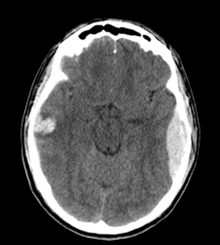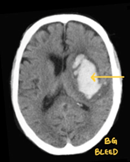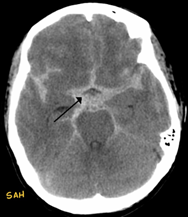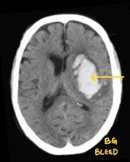Brain Haemorrhage
A person can have brain haemorrhage by a variety of conditions which include Trauma, Age-related co-morbidity which includes high blood pressure, Diabetes, people who are on blood thinners, brain haemorrhage inside brain tumour, rupture of brain aneurysms or AVM/AVF, vascular malformation of blood vessels of brain .etc… Here are some examples of brain haemorrhage
EDH – Extradural Haemorrhage
EDH usually occurs due to the breakdown of the brain artery, these are very serious condition because haemorrhage will never stop due to high pressure in the artery. They may also have counter-coup injuries like the above image where the patient has a brain contusion on the other side of the brain haemorrhage as well. The patient may have a loss of consciousness at the time of injury, then the patient regains consciousness after a few minutes, and again patient will become unconscious. People who will reach late at the hospital may have death due to this haemorrhage.

SDH – Subdural Haemorrhage
There are 4 types, we called it as acute, early subacute, late subacute and chronic subdural haemorrhage. Subdural haemorrhage is a majority of the time due to injury of brain veins which we called as bridging veins. They directly compress brain parenchyma and by doing that it causes brain parenchymal injury. Subdural Haemorrhage has a very high chance of having a convulsion. Subdural haemorrhage which cause compression over brain parenchyma required surgery. Surgery can be performed by Burr hole endoscopic drainage or craniotomy.

Basal Ganglia Haemorrhage/ Thalamo-capsular Hemorrhage
The Basal Ganglia Haemorrhage usually happens in people who have high blood pressure. This haemorrhage usually occurs due to a sudden rise in blood pressure. It will cause paralysis on the opposite side of the body and the left side haemorrhage may have difficulty in speaking. If this haemorrhage gets larger in size, it will require removal by surgery. The brain will have swelling and may develop midline shift which also required removal of the haemorrhage by surgery. The patient may have active bleeding from the site of haemorrhage which is also required to stop. Surgery can be done Endoscopically or through Craniotomy.

Subarachnoid Haemorrhage
Subarachnoid haemorrhage occurs between Pia and the arachnoid space of the brain. Major arteries supplying the brain remain at the sub-arachnoid space and they have natural turns at certain areas of the brain where these arteries may have ballooning and they may burst which will cause SAH. It’s a very serious condition where the patient may have changes of sudden death due to a burst of the major artery of the brain. When these patients visit to the hospital in time, they undergo brain angiography which we call DSA. They will require post-angiography coiling or clipping of this Aneurysm. These patients have 2 options where they can choose to have surgery by craniotomy and clipping of aneurysm or endovascular coiling ( without craniotomy surgery, occlusion of the artery by coiling ). Some patients may have Arterio-venous malformation or Arterio-venous fistula which also present as subarachnoid haemorrhage.

Haemorrhage in Brain Tumour
Haemorrhage in the brain tumour may occur in those people who have neglected brain tumour surgery. Patients who have haemorrhage inside the brain tumour required removal of the brain tumour as well as a biopsy of the same tissue. They may require chemotherapy and radiation at a later date after the biopsy report.




0 Comments
* * * Win Free Cash Instantly: https://testme.com.au/index.php?ygwco0 * * * hs=4f037e86e9d1c2aa8a76981ada7b0813* ххх*
0eyjya